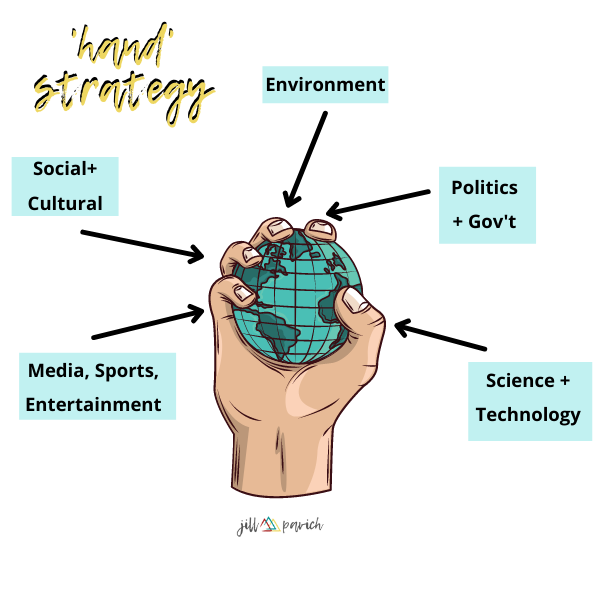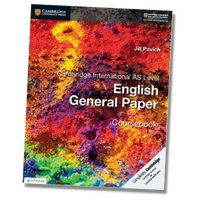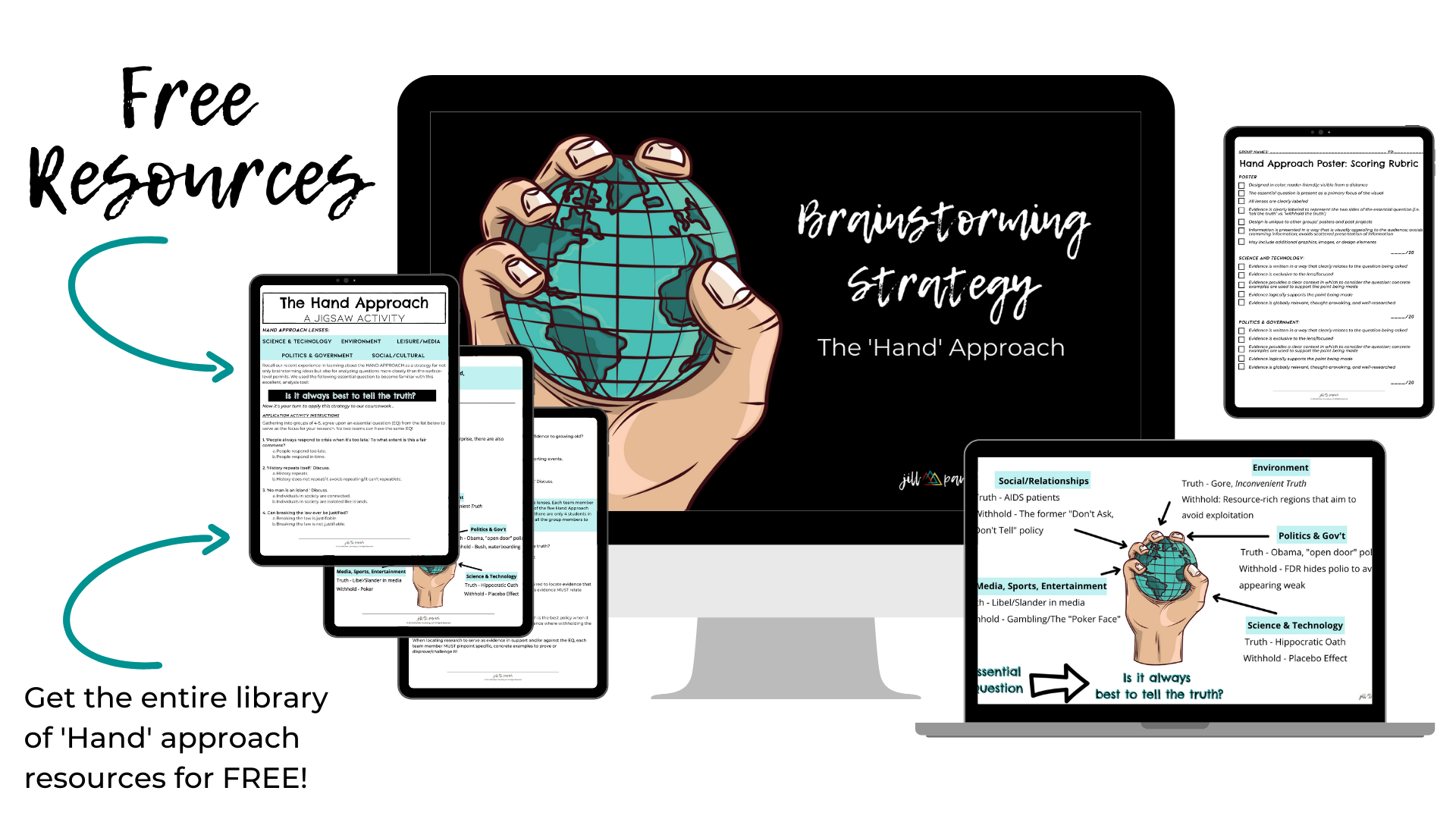A 'Handy' Brainstorming Strategy for Secondary ELA Writers

If there’s one thing our writers tend to invest in the least (ahem, besides revision!), it’s brainstorming. To them, generating ideas for an essay or a project usually conjures cold memories of a threateningly blank piece of paper or a blinking cursor -- and that can be *really* intimidating.
Meanwhile the benefits of brainstorming (in the classroom and in the real world) are countless. It helps creators:
- Gain a sense of vision surrounding a task
- Organize thoughts into more manageable and meaningful chunks
- Move forward in a designated direction and stay on track
- Iterate on/elevate ideas further; innovate
Yet our learners largely lack an idea generation system that’s structured enough to actually support them and 'speak back' inspiration…that is, until now.
- Whether you’re a teacher who’s brainstorming plans for this year’s curriculum, or you’re co-creating classroom content with your learners;
- Whether your students are writing an essay or generating ideas for an upcoming project;
- Whether you’re trying to tap into students’ personal passions or interests, or you’re trying to unearth your own…
The Hand method is your go-to strategy for generating ideas and setting the scope for any project or task.
In short, it helps your learners
- first, generate a range of diverse ideas;
- then, narrow those ideas down in order to dial-in focus + direction
So for starters, for every finger on your hand, there’s a category, or lens, associated with it; these serve as a starting point for thinking more critically about the layers of a topic, project-concept, or issue.
Let's say I’m getting ready to write an essay about technology, for instance. At first glance, the topic seems specific enough, but a closer look and the writer starts to realize: I don’t just have to write about computer wires and intel chips...
I can use the different lenses to see the topic from different angles, and thereby access the deeper layers of what is meant by 'technology': things like, medical, military, or election technology, for that matter.
Point being, the Hand method helps you see beyond the obvious and into the more nuanced aspects of a given topic.
If it helps, you can liken the idea of “lenses” to the filters your students typically use in their SnapChat, TikTok, or Instagram apps online. Quite simply, it’s a unique take on the original version.
And when it comes to attaching these to your hand, I associate the various fingers of the ‘Hand’ method with the following lenses:
THUMB - ‘thumbs up’ for Science and Technology
INDEX - we try not to ‘POINT’ the finger in Politics (though sometimes we do!)
MIDDLE - issues concerning the Environment are ‘central’ to our existence
RING - a Social + Cultural spot where relationship status is often featured (ex. wedding ring)
PINKY - the ‘little’ things in life that complete us, i.e. Leisure + Entertainment

Whether we’re challenging our students to draft an essay or develop a project from scratch, they can tap more deeply into their topics by applying these 'filters,' or lenses.
Imagine your students are all being asked to write an essay on the same topic: art.
With little to no thought going in, the chances of 30 out of 30 of your writers prosing about the meticulously placed dots in Claude Monet’s Water Lilies, or the mystere behind the Mona Lisa’s smile (or the surprisingly small size of the originally framed art!) run high.
If you’re lucky (go, best friend!), perhaps they boldly stretch their definition of 'art' to include sculpture, such as that of Thurtmose’s Nefertiti Bust.
But without much thought otherwise…your students aren’t seeing art beyond the obvious. And consequently, they’re missing out on a world of unique ways to unpack the topic’s deeper, less obvious layers -- which are chock-full of potential yet.
For example,
SOCIAL/CULTURAL - graffiti as art
POLITICAL - the art of cartooning
LEISURE - dance as an artform
In order to fully unlock their curiosity, our students need exposure to a range of diverse ideas all at once. In order to be creatively empowered, they need options worth exploring -- which is how the Hand helps!
Plus, in having a broader range of options, it puts our writers at a unique advantage for once. Instead of stretching those half-baked ideas that barely fit their point in the first place, they’re now swimming in great ideas (bam!).
Originally, I used the Hand approach to help my ELA 6-12 students generate ideas more quickly during timed writing tests, such as the ones they were required to take for the state of Florida or the on-demand exams they had to pass for college credits.
Here’s how I describe the use of lenses to that end --
 (as excerpted in a coursebook I wrote for a class I taught):
(as excerpted in a coursebook I wrote for a class I taught):
‘A strategy such as the ‘hand approach’ could be a useful way to help you generate more specific ideas [in an essay]. For example, if you wanted to discuss why people travel, you might initially talk about travelling for business or pleasure. However, you can make your argument more engaging by going beyond the more obvious ideas.
Try using the categories of the ‘hand approach’ to help you think of other reasons why people travel.
For example, what might be the political reasons for why people travel?
A politician on a campaign might travel across the region to meet more people and experience local issues directly.
How might cultural or environmental reasons play a role in why people travel? These are the kinds of questions you might ask yourself to generate ideas quickly.
This can be a useful approach when time is a factor [...].
Once you have developed effective strategies to generate ideas more quickly under pressure, you will have completed half of the brainstorming process.
The other half involves selecting the best of your ideas to include in your essay. You might have plenty of ideas, but you may not want to include them all in your response [nor should you try to]! An important rule to remember at this stage is to value depth of ideas rather than breadth. In other words, you should develop your ideas, rather than jump from one point to another without any detail…”
So in the strictest, most traditional sense, this brainstorming method holds a lot of weight for our on-demand essay writers (hello, status quo instruction). But if you know me, I’m not here to talk about essay-writing exclusively…
So let’s move onto using the Hand method to generate ideas for classroom projects that have the bigger picture (and whole student) in mind...
Exploring Student Passions
Our students deserve a range of experiences while under our care. The more topics they’re exposed to, the more likely we are to both stimulate curiosity and unlock interests they never even knew they had.
And as Mogul CEO and Forbes 30-under-30 icon Tiffany Pham puts it, you never know…
‘The silly brainstorm of an idea you began to conceptualize at age 16 could be the very thing you build your career on at age 27.’
As ELA teachers, we’re in a unique position to let our students’ interests run wild -- our writers can explore a range of topics across the disciplines, all while refining their communication craft along the way. In this sense, we get to nurture what Emilie Wapnick calls the ‘multipotentialite’ in all our learners.
Multipotentialite (n): someone with many interests and creative pursuits.
You can check out her TED Talk here.
But do me a solid and don’t limit your learners to essay-writing in order to explore the topics they’re drawn to, k?
First of all, sticking exclusively to essays as the sole means for assessing your writers is just downright inequitable.
But beyond all that, essay-writing is intimidating as hell. So the chances of your writers performing open-heart surgery on the page or letting their dreams swell big on the screen aren’t at all likely.
With my own scholars, I’ve had them create social media-style accounts on Padlet, where they micro-blogged about their passions and interests.
For their ‘account,’ I asked them to pin down a specific passion they’d like to explore through writing, then they applied the Hand approach brainstorm to the topic to narrow down the focus of their writing.
And this proved especially useful because if you’ve ever asked kids what they’re passionate about, then you likely know the typical response: a sea of blank stares, or some kind of really *basic* response like 'sports', or 'fashion', or 'social justice', or 'gaming'.
Now, to be clear: the way they feel about those subjects is way more nuanced, specialized, and complex, but that’s precisely how the hand approach helps them dig into that magic.
If you have a student who's ‘into Fashion,’ for instance, you might ask:
'What is it about fashion that draws you to it? Are you into sustainable fashion (environment)? fashion on a budget (politics/economics)? fashion for a cause (social/cultural)?'
Note how the Hand method naturally asks these questions of our students right away (again, a brainstorm that literally speaks back!). It automatically trains them to ask themselves the more critical questions and dig deeper than the surface initially allows.
From here, your writers can gain a better sense of who they’re writing for, thus making what they have to say that much easier!
In the real world, this process is called ‘niching down’, which involves dialing in or clarifying your focus; and in many cases, it’s this exact process that helps you stand out in a crowd.
‘By strategically pursuing the subcategories that will work best for your [business] brand, you can increase your profitability and better define what makes your company unique.’
Think about the kinds of people your students follow online. Each influencer or business is known well in some way, and it’s that exact angle of their niche that got them there!
So having this mindset early on -- being actively aware of it -- can serve our students in some seriously up-to-date ways.
All in all, the Hand strategy is definitely one that will translate for our writers from the classroom to the real world -- a tool that will not only help them write essays, but will help them recreate their interests again and again through every season of their lives.
Interested in gaining access to the entire library of free resources that go along with this strategy? Visit www.jillpavich.com/hand for instance access.
Updated on: 2/3/22





